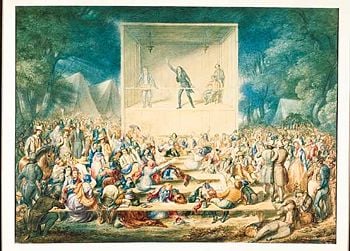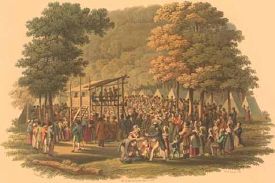Difference between revisions of "Camp meeting" - New World Encyclopedia
m (Robot: Remove contracted tag) |
m (Unlink unwanted links) |
||
| Line 3: | Line 3: | ||
[[Image:Religious Camp Meeting (Burbank 1839).jpg|thumb|right|350px|A [[watercolor]] painting of a camp meeting circa 1839 (New Bedford Whaling Museum).]] | [[Image:Religious Camp Meeting (Burbank 1839).jpg|thumb|right|350px|A [[watercolor]] painting of a camp meeting circa 1839 (New Bedford Whaling Museum).]] | ||
| − | The '''camp meeting''' is a phenomenon of [[United States|American]] frontier [[Christianity]]. The movement of thousands of persons to what had previously been trackless wilderness in the | + | The '''camp meeting''' is a phenomenon of [[United States|American]] frontier [[Christianity]]. The movement of thousands of persons to what had previously been trackless wilderness in the 18th century in America had led to something of a [[religion|religious]] vacuum. Not only were there few authorized houses of [[worship]], there were even fewer [[ordination|ordained]] [[religious minister|ministers]] to fill their pulpits. The "camp meeting" was an innovative response to this situation. Word of mouth told that there was to be a religious meeting at a certain location. Due to the primitive means of [[transport|transportation]], if this meeting was to be more than a few miles' distance from those attending, it would necessitate their leaving home for its entire duration, or as long as they desired to remain, and [[camping]] out at or near its site, as usually there were neither adequate accommodations or the funds necessary to obtain them. At a large camp meeting, many came from over a large area, some out of sincere religious devotion or interest, others out of curiosity and a desire for a break from the arduous [[frontier]] routine, although many in this latter group often became sincere converts as well. |
[[Image:Methodist camp meeting (1819 engraving).jpg|thumb|left|275px|An [[engraving]] of a [[Methodism|Methodist]] camp meeting in 1819 (Library of Congress).]] | [[Image:Methodist camp meeting (1819 engraving).jpg|thumb|left|275px|An [[engraving]] of a [[Methodism|Methodist]] camp meeting in 1819 (Library of Congress).]] | ||
Revision as of 04:50, 5 November 2008
The camp meeting is a phenomenon of American frontier Christianity. The movement of thousands of persons to what had previously been trackless wilderness in the 18th century in America had led to something of a religious vacuum. Not only were there few authorized houses of worship, there were even fewer ordained ministers to fill their pulpits. The "camp meeting" was an innovative response to this situation. Word of mouth told that there was to be a religious meeting at a certain location. Due to the primitive means of transportation, if this meeting was to be more than a few miles' distance from those attending, it would necessitate their leaving home for its entire duration, or as long as they desired to remain, and camping out at or near its site, as usually there were neither adequate accommodations or the funds necessary to obtain them. At a large camp meeting, many came from over a large area, some out of sincere religious devotion or interest, others out of curiosity and a desire for a break from the arduous frontier routine, although many in this latter group often became sincere converts as well.
Freed from their daily routines for the duration of the meeting, unlike traditional religious events these meetings could provide their participants with almost continuous services; once one speaker was finished (often after several hours) another would often rise to take his place. These sorts of meetings were huge contributing factors to what became known as the Second Great Awakening. A particularly large and successful one was held at Cane Ridge, Kentucky in 1801, where the Restoration Movement began to be formalized. They gained wide recognition and a substantial increase in popularity in the aftermath of the American Civil War as a result of the first Holiness movement Camp Meeting in Vineland, New Jersey in 1867. Ocean Grove, New Jersey, founded in 1869, has been called the "Queen of the Victorian Methodist Camp Meetings." At the end of the nineteenth century, believers in Spiritualism also established camp meetings throughout the United States.
In 1807 the first Camp Meeting was held in England at Mow Cop. The Wesleyan Methodists disapproved and subsequently expelled Hugh Bourne "because you have a tendency to set up other than the ordinary worship" which led eventually to the formation of the Primitive Methodist Church.
In 1815 in what is now Toronto, Ohio, the Rev. J. M. Bray, pastor of the Sugar Grove Methodist Episcopal Church, began an annual camp meeting that, in 1875, became interdenominational upon its purchase by what is now the Hollow Rock Holiness Camp Meeting Association. The association, which still runs the camp, claims that it is the oldest Christian camp meeting in continual existence in the United States.[1]
Camp meetings in America continued to be conducted for many years on a wide scale and some are still held today, primarily by Pentecostal groups but by some other Protestants and Spiritualists as well. The revival meeting is often felt to be a modern-day attempt to recreate the spirit of the frontier camp meeting.
Notes
- ↑ Kiaski, Janice. Holiness at Hollow Rock. HollowRock.org. Retrieved 2007-07-26.
ReferencesISBN links support NWE through referral fees
- Gillespie, Paul, and his students (editors), Foxfire 7, Anchor Books, New York 1980, ISBN 0-385-15244-2
- Moore, William D., 1997. "'To Hold Communion with Nature and the Spirit-World:' New England's Spiritualist Camp Meetings, 1865-1910." In Annmarie Adams and Sally MacMurray, eds. Exploring Everyday Landscapes: Perspectives in Vernacular Architecture, VII. Knoxville: University of Tennessee Press. ISBN 0-87049-983-1.
- Rawlyk, George. The Canada Fire: Radical Evangelicalism in British North America, 1775-1812. McGill-Queen's UP, 1994.
External links
Credits
New World Encyclopedia writers and editors rewrote and completed the Wikipedia article in accordance with New World Encyclopedia standards. This article abides by terms of the Creative Commons CC-by-sa 3.0 License (CC-by-sa), which may be used and disseminated with proper attribution. Credit is due under the terms of this license that can reference both the New World Encyclopedia contributors and the selfless volunteer contributors of the Wikimedia Foundation. To cite this article click here for a list of acceptable citing formats.The history of earlier contributions by wikipedians is accessible to researchers here:
The history of this article since it was imported to New World Encyclopedia:
Note: Some restrictions may apply to use of individual images which are separately licensed.


